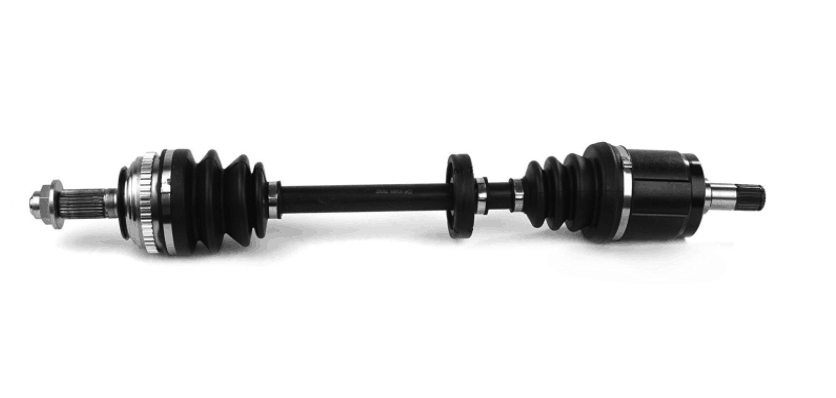What does a CV joint do anyway? A CV joint (short for Constant-Velocity joint) transfers power to the wheels exactly like a drive shaft would on a rear wheel drive car. The rub with a CV joint is that it has to transfer power at MULTIPLE ANGLES.
There are two CV joints per axle. They are called the inner CV joint and outer CV joint. The outer joint is the one that faces the drive wheel(s). The inner joint is located right where the transmission hooks to the axle.
This means that unlike a driveshaft, which is a tube that connects a transmission to the rear axle directly, there are two points that are constantly bending and rotating at very high speeds. This is why they are so prone to wearing out.
Bad CV Joint Symptoms
A CV joint going bad is one of the most common problems that occurs with a vehicle when they get to have higher mileage on them. Once you start to hear or feel the symptoms, it could be hours, days, or months before the CV joint fails. That being said, there’s no guarantee that it won’t go out immediately. It needs to be addressed immediately.
Clunking Noise– One of the most common symptoms of CV joint issues is a noise that can be described as clunky or chunky. Typically, when there is a CV joint problem, the clunking noise will occur when turning the steering wheel. Sometimes it’ll only occur when turning left or right.
Grease on Tire– Take a look at the inside of your tire. The easiest way to do this is to cut the wheel all the way over and take a look at it. There’s a rubber “boot” that goes over the axle shaft right by the wheel. If it is missing or damaged, it’s a pretty safe bet that the CV shaft is damaged as well.
Car Not Moving– For some people this may go without saying, but if your car is not moving when in gear, it may be a pretty good indicator that the CV joint is shot. Now, it’s no guarantee. It’s also possible that the transmission could be completely out of fluid (or pretty dang close. If that’s the case it may be prudent to read up on low transmission fluid diagnosis. You may have completely missed them. Either way a visual inspection will tell you a lot. You should either see ATF everywhere or an axle that is no longer connected to a wheel.
Vibration at Speed– As the vehicle speed increases, you may experience a vibration. That’s a pretty common symptom that there’s an issue with the CV shafts. It’s also a sign that you have a tire that’s out of balance as well. It’s a good idea to check your tire pressure and make sure that it looks like they have been wearing evenly before you assume it’s a CV joint.
How to Tell if a CV Joint is Bad
One of the easiest and best ways to check if a CV joint is bad or worn out is to perform a visual inspection. One of the best signs that there is a problem with it is if the boot looks worn, ripped, or missing entirely.
Also, look to see if their is grease on the inner part of the tire. This is a sure sign that the joint has gone bad. Once the boot is ripped. It begins to allow all manor of particles to get in there.
If you don’t find anything during your visual inspection, don’t assume that everything is fine. It may still be time to have a mechanic diagnose what has happened to cause the noise or vibration that caused you to Google this in the first place.
CV Joint Failure
When you hear the signs that the CV joint is going bad, it’s important to heed them. Because when it does fail, it fails spectacularly. The car will be going down the road and all the sudden the RPM will skyrocket because the engine no longer has a connection to the wheels. This is usually accompanied by a thud and hard clunking as the CV shaft beats against the exhaust and anything else that it can hit.
Can CV joints cause vibration?
Yes, CV joints can cause horrible vibration. The vibration will get worse typically as the vehicle speed increases. Sometimes the vibration will “top out” at a certain speed and begin to feel better as you continue to gain momentum.
If you feel a vibration though, don’t just assume that you have a bad CV joint. You could also just need a wheel alignment, or a tire could be out of balance. I would recommend looking there before assuming it’s a CV shaft, unless you feel some of the other symptoms. These are listed above, but include clunking when going around corners or oil around your inner tire.

